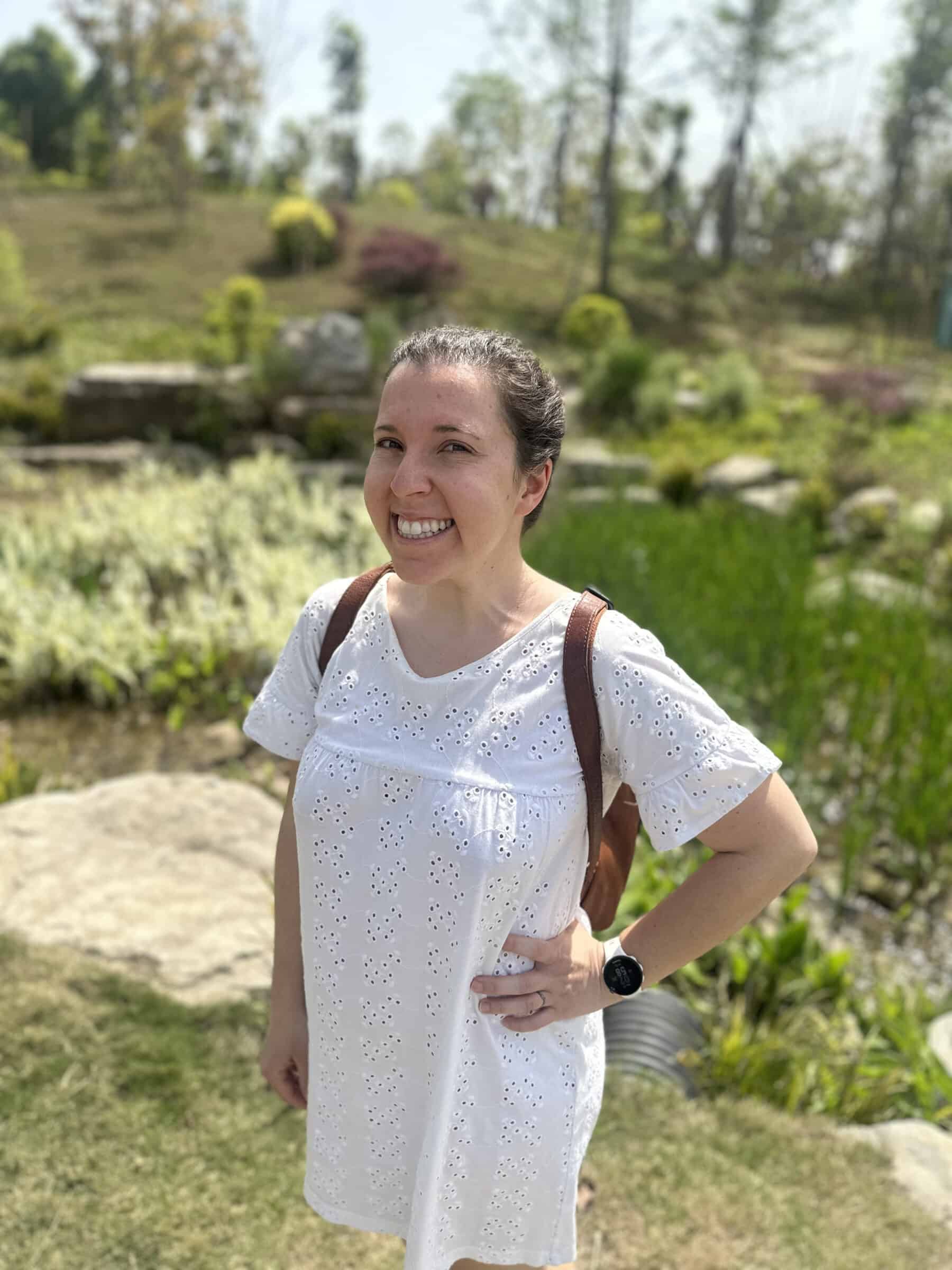The final section!
Day 12: Chunxi Road
Chunxi Road is the main shopping street in Chengdu, and after a lazy morning we walked there along the river where I feasted on a (very tasty) chicken burger from homegrown fast-food chain Dicos. Most days took us along the river at least a little bit, in fact, and it’s a lovely one. Some stretches are quiet, others are filled with people, and at some points there are bags full of fish and buckets of turtles all over the place. I regret to inform you that we did not cross the road to investigate the ‘Chicago street food’ joint. But talking of food: that night provided another rare break from Chinese when we discovered a Thai/Vietnamese place inside the anime mall, and I savoured the beef brisket curry!


Day 13: Chongqing

Chongqing! I have to be honest and say that this city made it into our itinerary thanks entirely to the YouTube recommendation algorithm, which threw me so much of a totally crazy, multi-dimensional urban futurescape that I had to see it for myself. Chongqing is unusual in that it’s a directly-administered municipality, so not part of any province, and has a total population of over 30 million although the city itself is ‘only’ around 23 million. It’s also between 1 and 1½ hours away from Chengdu by high-speed train, of which there are many each day, so apparently it’s quite common to commute between the two.
Unfortunately Randi wasn’t feeling well on the morning of our day trip, so I left her to rest and recuperate in Chengdu while I joined our private guide, Chris, for a whistlestop tour of the sites. I had booked a tour with Chris before we left and he was exceptionally helpful in listing all of the possible things which we might want to see around the city and then crafting a bespoke itinerary – highly recommended if you’re looking for someone to take you around!
In our planning we had jokingly referred to Chongqing as the ‘dystopian megacity’, so I was surprised to find that it was actually very green. We started at the famous Kuixinglou Square, which feels like it should be on the ground floor until you walk over to the edge, look down and discover that you’re actually 22 storeys high. I’ve never been brave enough to hold my phone out over a sheer drop, so my video is much less compelling than all of the other ones you can find on YouTube and TikTok, but rest assured it is a very strange and cool experience.



Our next stop was the equally-famous Liziba monorail station, where the train passes through – and makes a stop in the middle of – a residential apartment building. For convenience, this would surely put all other homes to shame!
The rest of our tour included the tranquil E’ling Park, the central Jiefangbei Square, the remains of the ancient city walls and the retro socialist dormitory buildings of Minzhucun. According to Chris, this is a favourite spot on the tour for Eastern European tourists who feel nostalgia – at least on behalf of their parents – for a ‘labour village’ constructed to house workers for the state-owned motorcycle factory next door.
During the economic reforms of the 80s, the factory was closed and has since been demolished and replaced by a luxury shopping mall. The residential buildings survived, however, and the neighbourhood has since been revived with plenty of people milling about when we were there. It’s a fascinating historical contrast to the implosion of the USSR, which we know was studied very closely by China’s CCP as a ‘what not to do’ guide to their own survival.
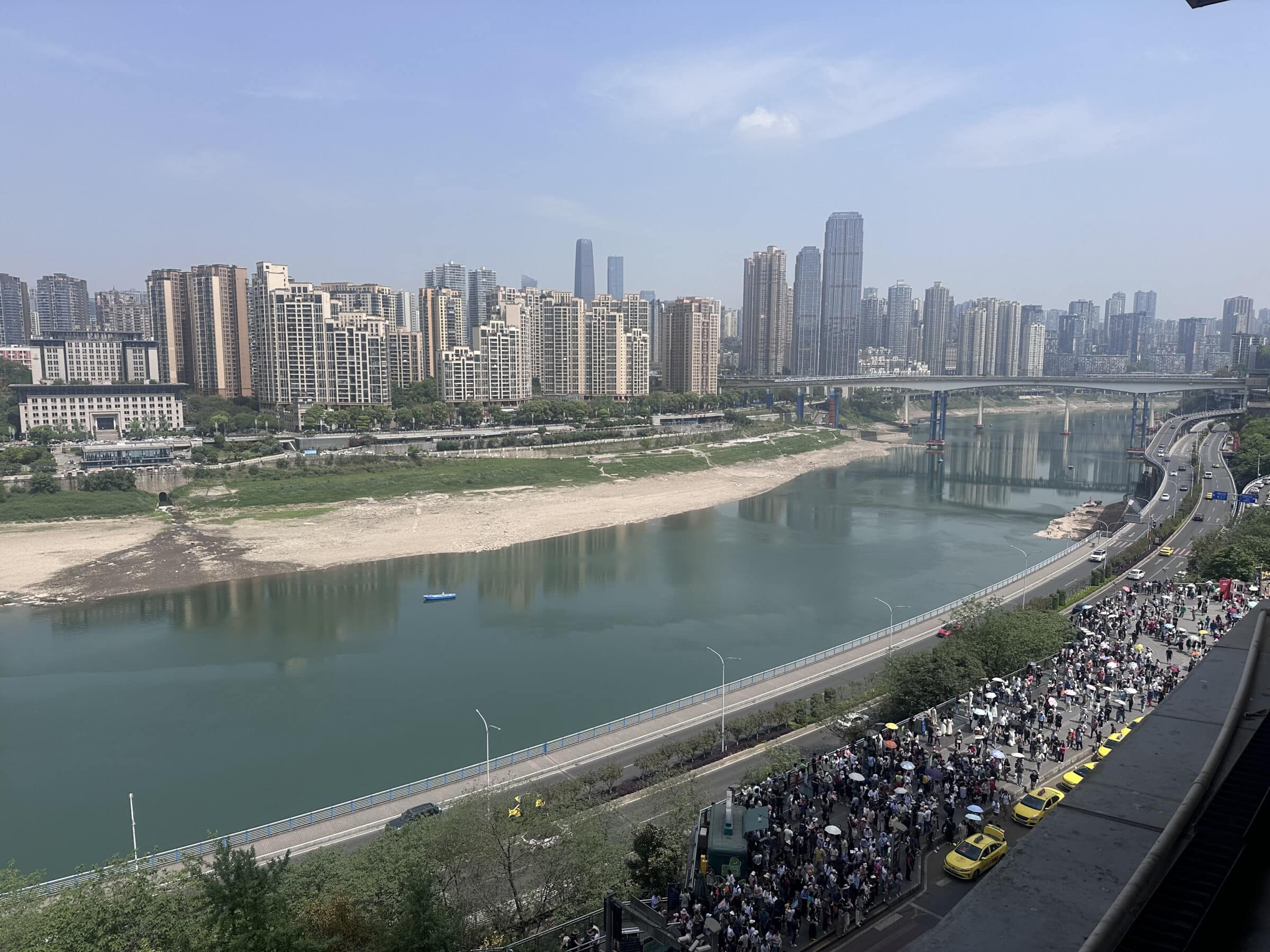
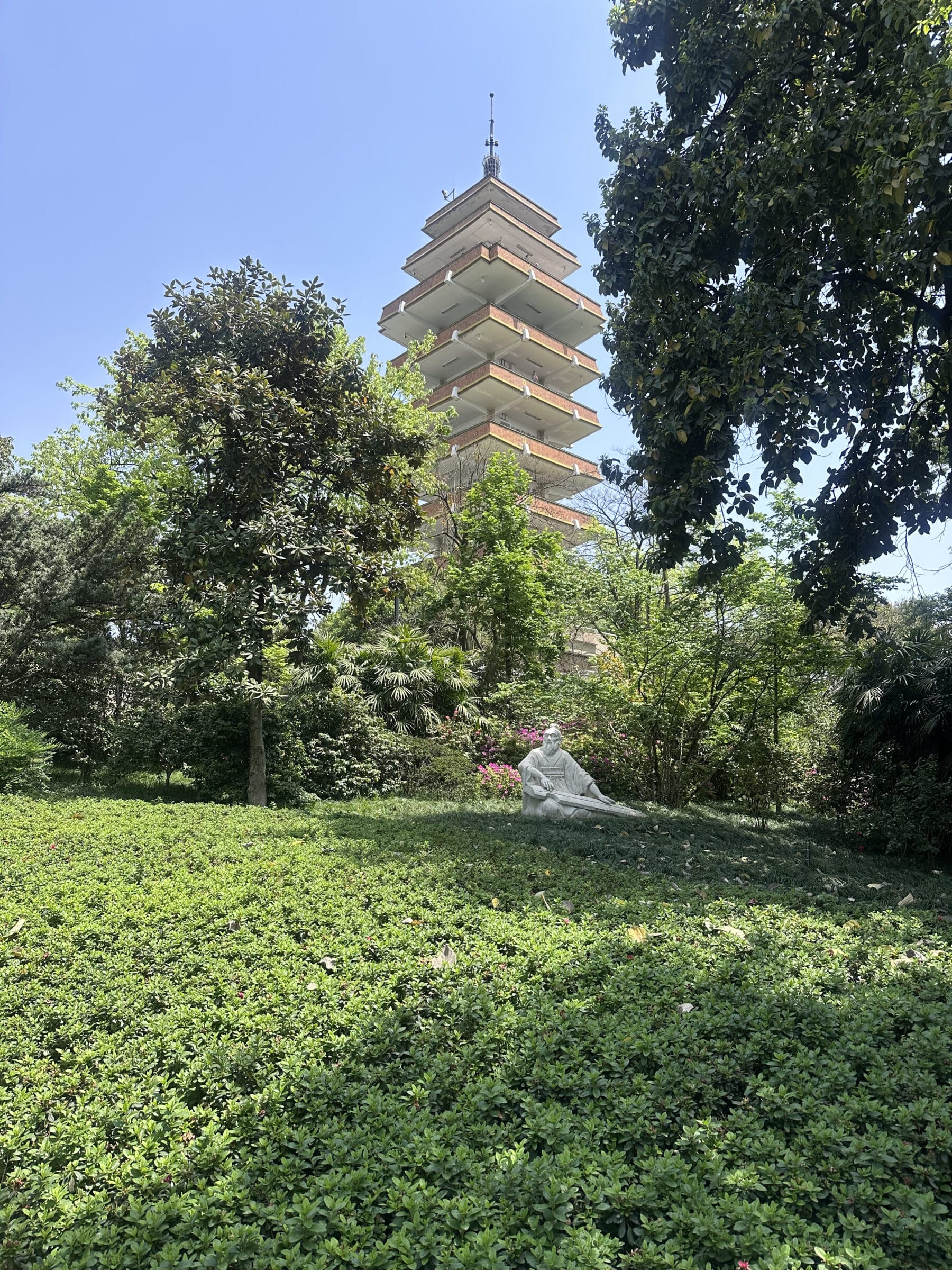
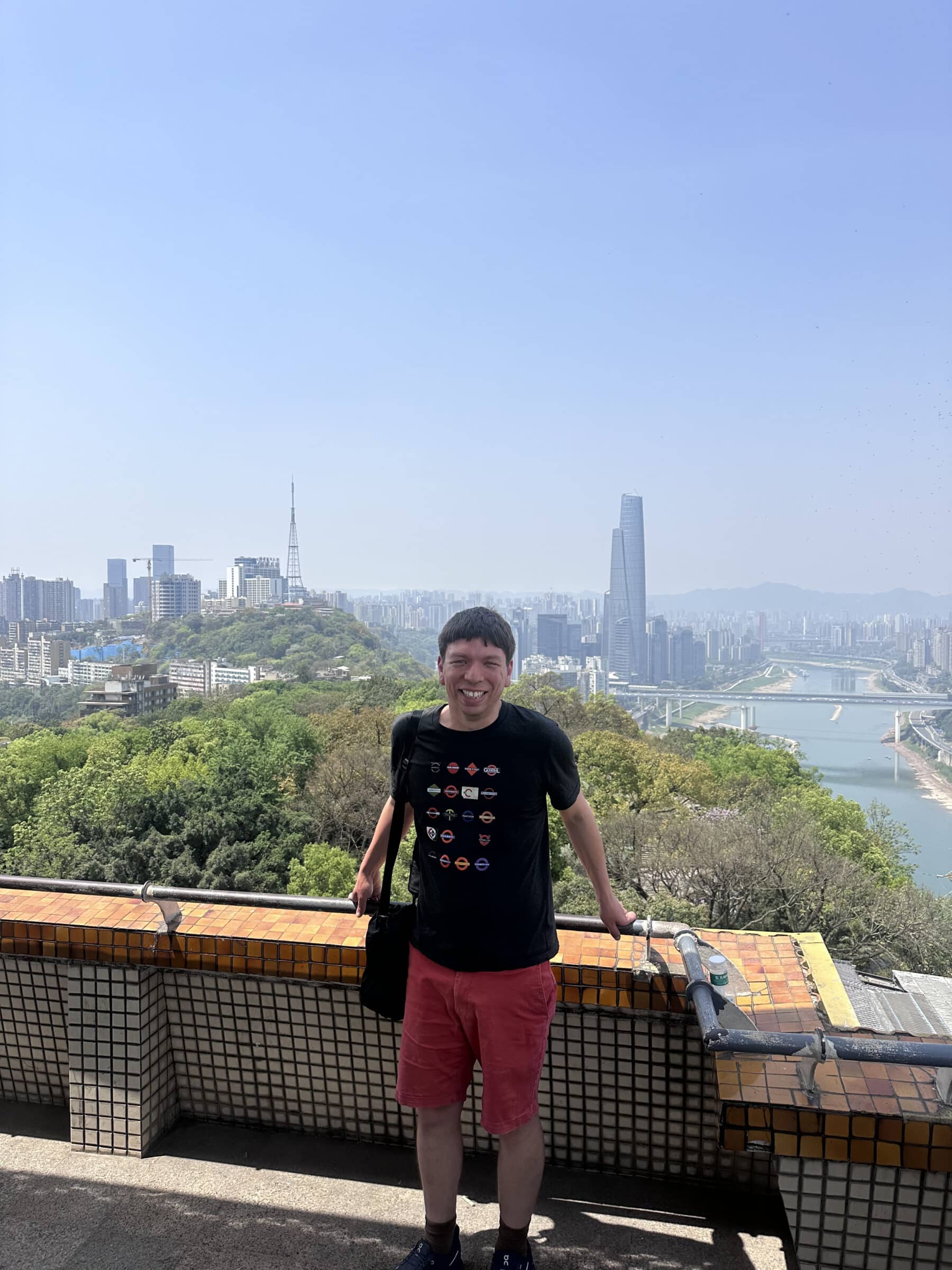






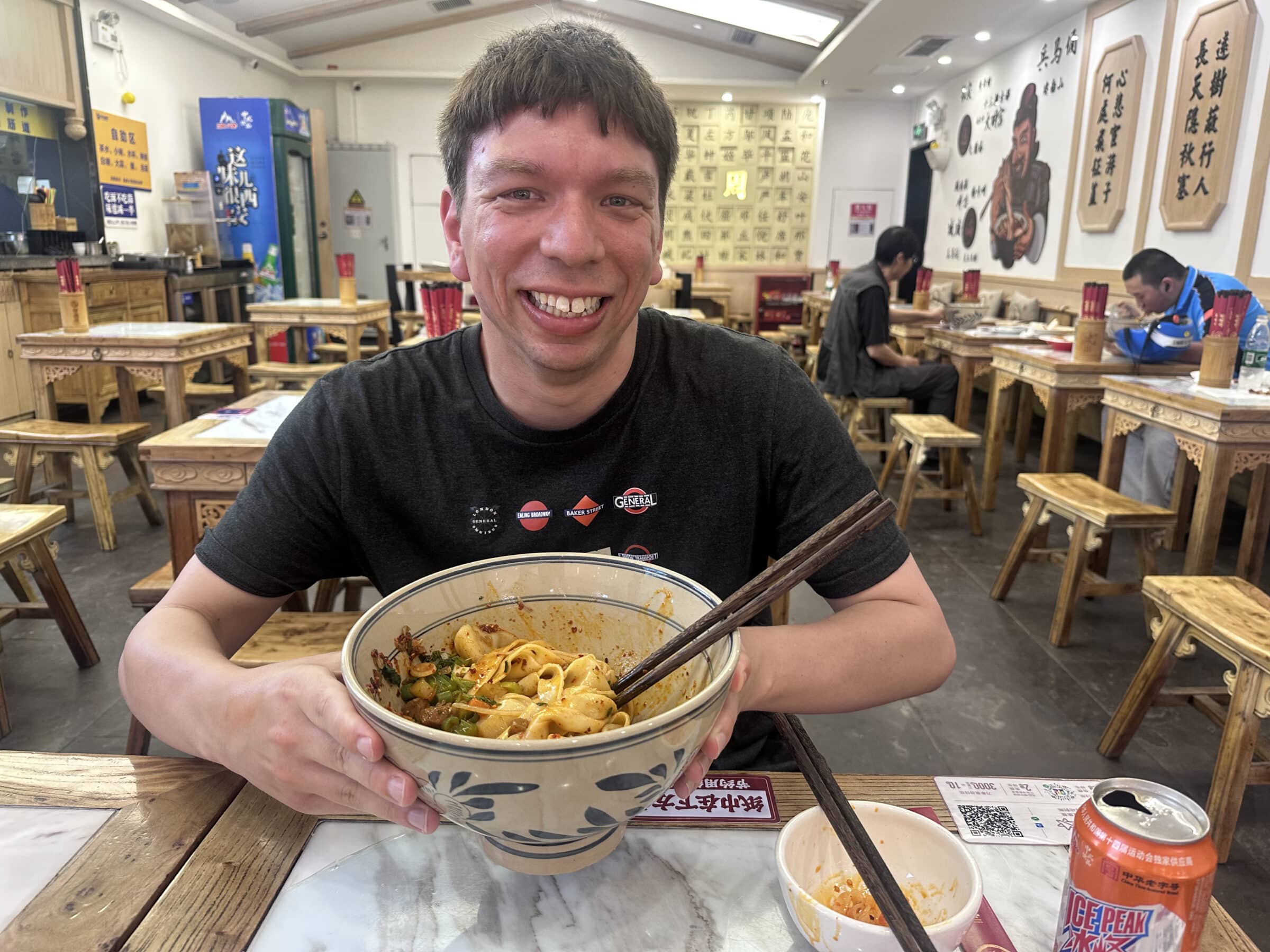
Once the tour was over, I wandered by along the ‘Mountain City Alley’ – which sits high up alongside the Yangtze River – until I came to the ruins of an old French hospital, where the basement has recently been rediscovered and evacuated. In Chongqing, even their archeological ruins exist over multiple levels!
Then I headed back to Chengdu with lots of stories from Chris to share with Randi, who was thankfully feeling better enough to join me for dinner before walking home beside Chengdu’s own beautiful river.


Day 14: Tianfu Greenway & Livehouse
I’ve already talked about the Tianfu Greenway last time, so the short version is that we went back and rode some more! We almost didn’t: it was very hot outside, but cycling turned out to be way more cooling than walking. This section started at the ‘Global Center’ [sic] on a section of Metro where all of the stops have names like Hi-Tech Zone, Financial City and Incubation Park. The scenery was lovely.
That night we also wanted to visit another live music venue again before leaving China, so we did so after eating dinner at a trendier-than-usual fusion restaurant which somehow offered mango beer! It was a lively Friday night and a few live musicians were playing outside along the river, which we enjoyed before heading to another indoor livehouse venue. This was less cutesy than the area we discovered in Beijing – and for the first time we actually noticed a few other Western tourists floating around – but the vibe of the music was chill and relaxed. It was a great sorta-final night of our holiday… ‘sorta’ because our flight wasn’t actually leaving until 1.45am on Sunday morning, so we still had one more day in Chengdu…




Day 15: Last Day in China

After checking-out of our hotel, we headed to the Wenshu Monastery area for lunch for a noodle place which Randi had been wanting to try. Sadly, some mystery ingredient in a few of our meals in China had occasionally been giving her a mild allergic reaction and today this struck again – nothing serious, but requiring an emergency second lunch!
Afterwards we returned to Tianfu Square and stumbled half by accident into the (free!) Chengdu Museum, albeit sadly too late for the special exhibition on Sherlock Holmes which had recently ended. I didn’t find the main exhibits particularly enthralling – and did not even consider trying the new special exhibition on flutes – but as we sat in the café, we did have the lovely experience of two Tibetan teenagers approaching us and asking if it was OK to chat for a while. We agreed, of course, albeit through the medium of translation apps on each side.
In fact, they were not particularly interested in our lives (totally reasonable!) but were clearly experiencing their own form of culture shock in Chengdu and mostly wanted to show us lots of photos and videos of their homeland. They did ask us if we found things in China to be expensive, so the costs in Chengdu were also clearly on their mind. It was an unexpected reminder of how vast and diverse China itself is.

We had a final dinner at the Thai/Vietnamese place – they remembered us, so we clearly stand out. Then we collected our bags, said goodbye to the view from our hotel and rode the metro to the airport. An airport procedure I’ve never seen before: after checking in your bags, wait for 3 minutes in a separate area in case your name appears on a screen for some sort of additional security check. After 3 minutes have elapsed with no activity, you’re free to go.
If you’ve made it all this way, thanks for joining us on our China explorations. We’re so lucky that we were able to go, and it has ticked off a huge item on my travels wishlist. Although I am going to have to restrain myself from purchasing a scratch-off map of Chinese provinces and trying to visit them all… 😉
Continuing where I left off with our two weeks in China…
Day 6: Train to Chengdu, Tianfu Square & Kuanzhai Alley
On Thursday morning, we had a very early start and made our way to Beijing West station for the 7am to Chengdu East. The process of buying tickets was a little strange: they technically go on sale only two weeks beforehand, but Trip.com will take your money and try to snag it once it’s available, with multiple fallbacks in case your first choice is unavailable. Fortunately, we got 1st class tickets on one of the fastest of the five daily high-speed trains, which range between 7½ – 11½ hours to cover the roughly 1850km (1150 miles) distance.
Incidentally, Amtrak’s meandering route from New York to Chicago is actually about the same distance. Riding one of its three trains a week will take about 27½ hours, if it runs to schedule.
Like every other station we travelled through, Beijing West was large and well-organised. For breakfast we discovered that ‘tea eggs’ are a thing – think a hard-boiled egg, but boiled in tea – which is something we should absolutely do. But even more impressive is the fact that Chinese trains allow you to order food delivery to your seat! This was implemented a few years ago after complaints about the railway’s onboard monopoly. So now, in addition to ordering from the train itself, the official railway app – which, like everything else, is actually just a mini program within AliPay – allows you to order from a long list of participating restaurants as well. At your chosen stop, your meal is brought onboard and delivered to your seat by the train staff.
Honestly, I expected that the train itself would be infuriatingly fast and smooth, which it was. I expected that I’d be able to look out the window and see intensive road or apartment construction rather than stagnant land, which I did. But I wasn’t quite ready for the fact that China has the world’s best, fully-integrated system for market-based food delivery on a bullet train moving at 250km/h. It’s a perfect example of where China chooses to put its layer of commercial competition: at the perfect place to fully leverage its fantastic public infrastructure.

So then: Chengdu! This city is the capital of the Sichuan province in Southwest China, with warmer temperatures than Beijing, and is known for having a relaxed and laidback vibe. This is certainly true in general, although my immediate impression when getting off at the busy station (perfectly on time) was that this was more like the China I had been imagining: more people, more bustle. We took the Metro (which didn’t exist until 2010, and now has 15 lines) to a stop 10 minutes from our hotel, and the contrasts with Beijing only got bigger. The urban landscape is just massive, with tall buildings not just clustered in a central business district but stretching as far as the eye can see, although that’s not as far as the eye might be able to see without the pollution, mind. We’d also picked a very different hotel from Beijing, opting for the 5* luxury vibe with magnificent views over the city.
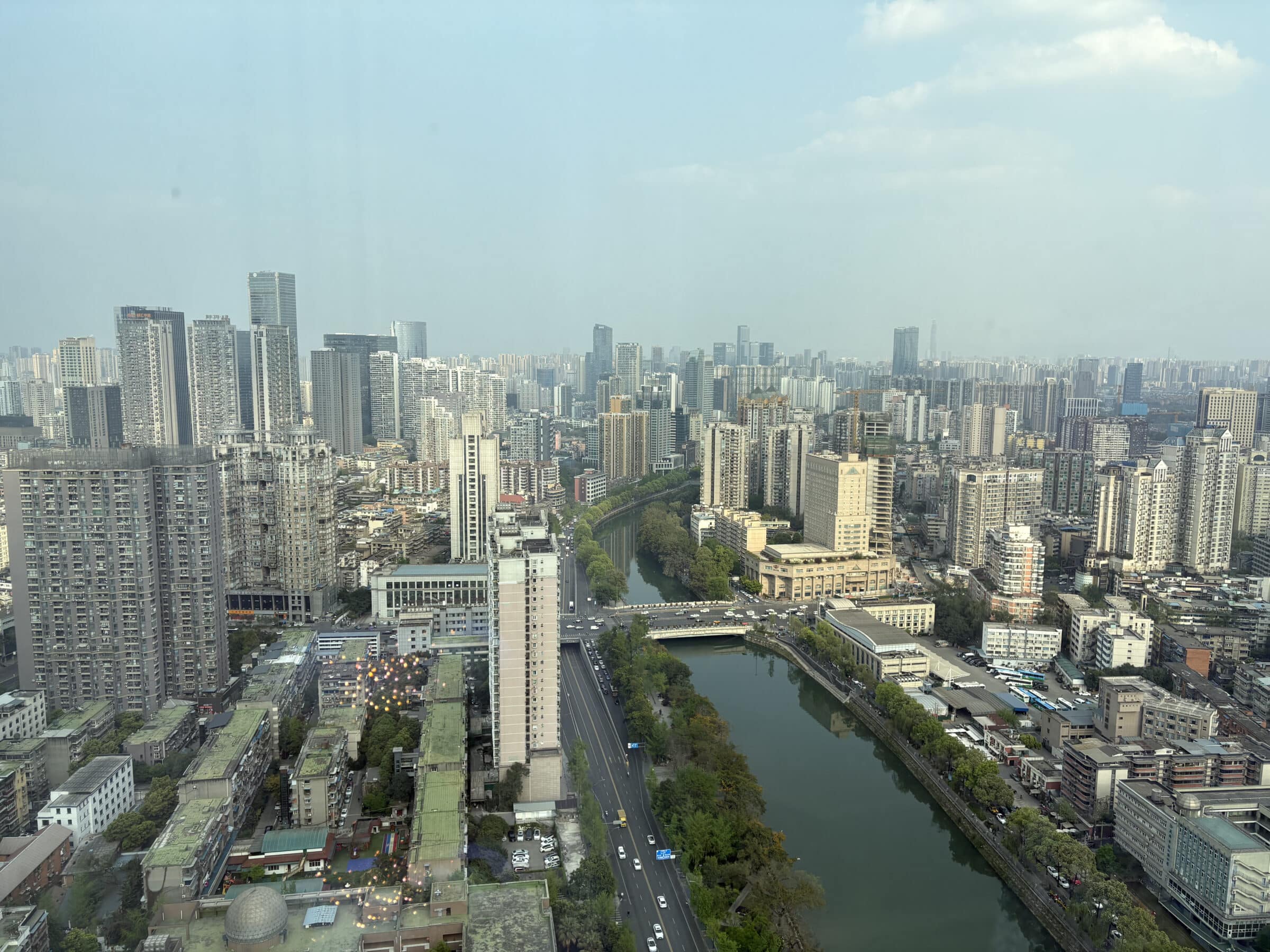
Our hotel was in a perfect spot by the river and only a short walk from Tianfu Square, another giant public plaza with a shopping centre/metro station cut into the ground beneath, and all carefully guarded by a giant Chairman Mao statue looking on. We returned here a lot for meals over the next week, but on our first night we ventured a bit further out to the famous Kuanzhai Alley, enjoying dinner on little tables outside.


Day 7: People’s Park & Food Tour

The next day we headed to People’s Park, a large park in the centre of Chengdu with lots for the people to see and do including boating on the lake, food stalls, public music and dancing, or sharing tea and playing mahjong together. (In general, everywhere you look in Chengdu you’ll see serene-looking retired people sitting in the sun and playing cards.)
Because we’re weird, our favourite feature of the park on our first visit was the series of security-themed sculptures (data security, biosecurity, security in space, etc.). Elsewhere there are war memorials to commemorate resistance against the “Japanese devils” (not my language) and a series of historical displays explaining that national security is “entering a new era” and that “if our party wants to consolidate its ruling position and unite and lead the people to uphold and develop socialism with Chinese characteristics, ensuring national security is the top priority”. It’s not only teatime in the People’s Park.






That evening we had our second Lost Plate food tour, this time led by Fiona and travelling between spots via tuk tuk. We were lucky to get a very interesting group of travellers, including a couple of Americans, and I was pleased to discover that actually I can perfectly handle the ‘normal’ level of Sichuan spice for which this region is known for. Overall, though, we preferred the diversity of food in Beijing to Chengdu, although Chengdu absolutely came out the winner for real gelato ice creams.


Day 8: Qingcheng Mountain

We had clearly started to imbibe some of the relaxed Chengdu way of life and took our time getting to Mount Qingcheng the next day, which required a subway to a train to a taxi for the hiking-friendly ‘Back Mountain’ area. (A scrolling message on the train requested passengers to “promote traditional values and advocate civilised values”, which I found a little too vague to know if I was complying with.)
So it was already lunchtime when we arrived at the Taian Ancient Village at the base of the mountain, and while eating at one of the many, many, many food spots I kept staring at Google Translate to appreciate the bizarre posters on the wall, which included “No matter how many times my customers abuse me, I will treat them like my first love” and a long list of deeply confusing prohibitions (?) including “wearing a bikini in winter”, “being even more arrogant than Bin Laden” and “driving an Alto and insisting that an Audi is ugly”.
If you’re planning on doing a proper hike you should absolutely leave more time than us, not least because the cablecars stop running. But we enjoyed our scenic walk along the mountain paths until turning back, although we didn’t love the incredibly slow cablecar itself, which took over 20 minutes on the ride up. A small observation, but one which speaks to a wider pattern, was passing a guy employed to pick up litter and empty the bins along this nature trek. This was a common theme in China (e.g. someone polishing surfaces on the metro, or the train attendant who tucked in the dangling straps on all the overhead bags) and I often associate this type of careful labour with a society which is big on people but low on automation. But China’s extremely high on automation! It’s a combination of efficiency with high personal standards, and it’s just nice to be around.


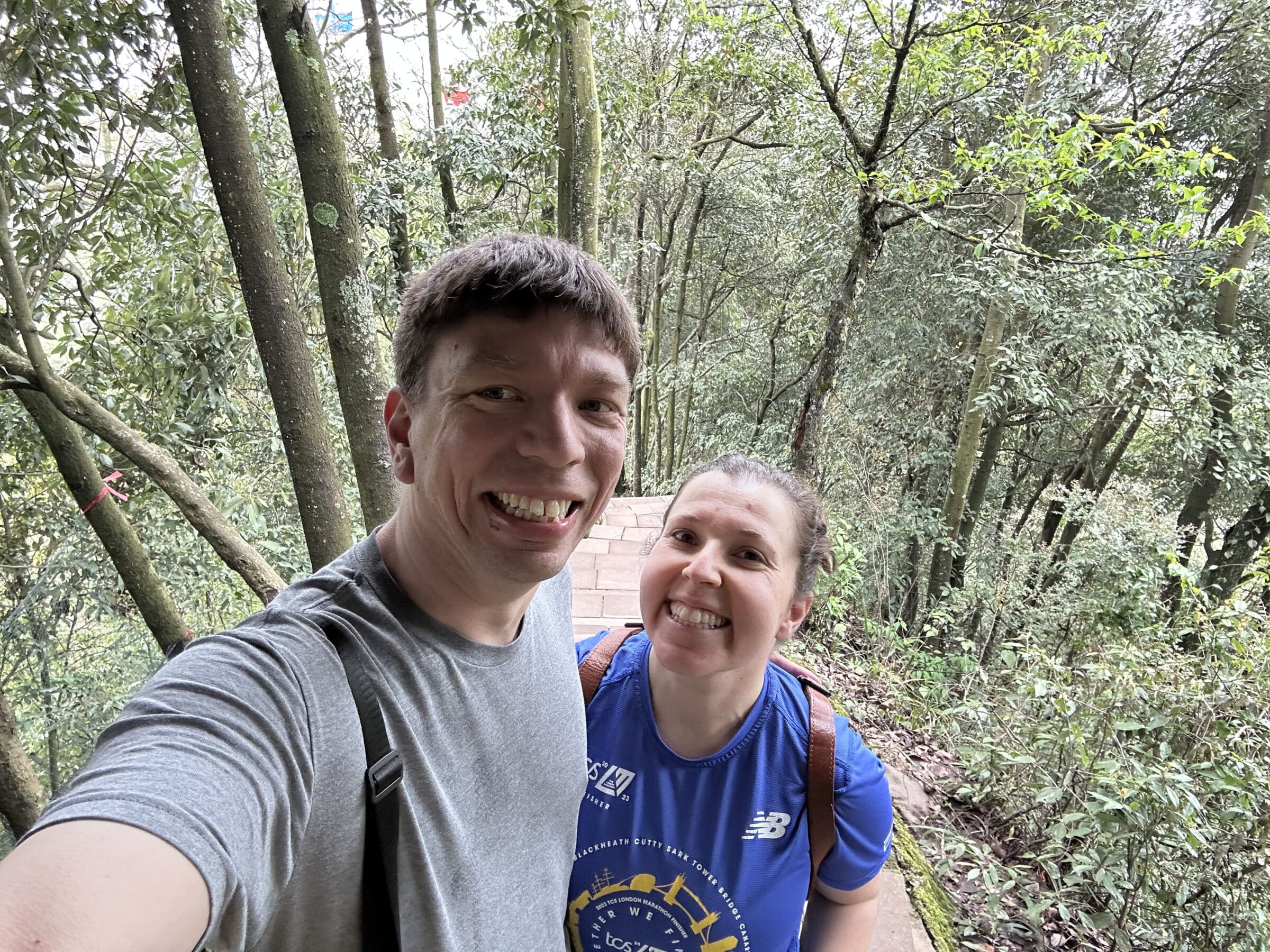
Final cultural encounter for the day: back in town, we ate dinner in another shopping centre where it slowly dawned on me that all of the non-food shops were anime-themed, and there was an absolute explosion of cosplay.
Day 9: Jinli Street & Marriage Market


After a lazy morning of reading (I had to finish the Cromwell trilogy somehow) we had lunch at Jinli Street, Chengdu’s other famous market of alleys, before Randi was extremely excited to relive her childhood by enjoying some Dairy Queen Blizzards. Apparently it’s a tradition for the server to turn these upside down before handing them to you, and Randi was also thrilled to confirm that China has retained this tradition, so Dairy Queen wins a lot more points from us for cultural authenticity than Pizza Hut.
Then we headed back to People’s Park because I realised we had missed one of the most fascinating aspects of Chinese society: the dating corner, or ‘marriage market’. These are rows upon rows of sheets (blue for boys, pink for girls) with people looking for partners, albeit apparently it’s often more likely that it’s their parents who have lost patience and posted on their behalf. The form is standardised (name, date of birth, height, unmarried/divorced/widowed, a personal section and the “mate selection criteria”) and only very rarely includes photos.
You could spend hours and hours here, just to get an insight into what ordinary people value and need. Men often want “emotionally simple” women, while being from a “native” family is a criterion for many . (It was later explained to me that being “native” to the city or province often brings privileged access to public services such as education or housing.) Insurance, healthcare, owning a car or house feature prominently, as you might expect. Many specify “no bad habits” in a partner, which seems very ambitious. One ambitious-sounded woman specified that she was a member of the Party. All of life is here, basically, and on this sunny Sunday the place was packed.
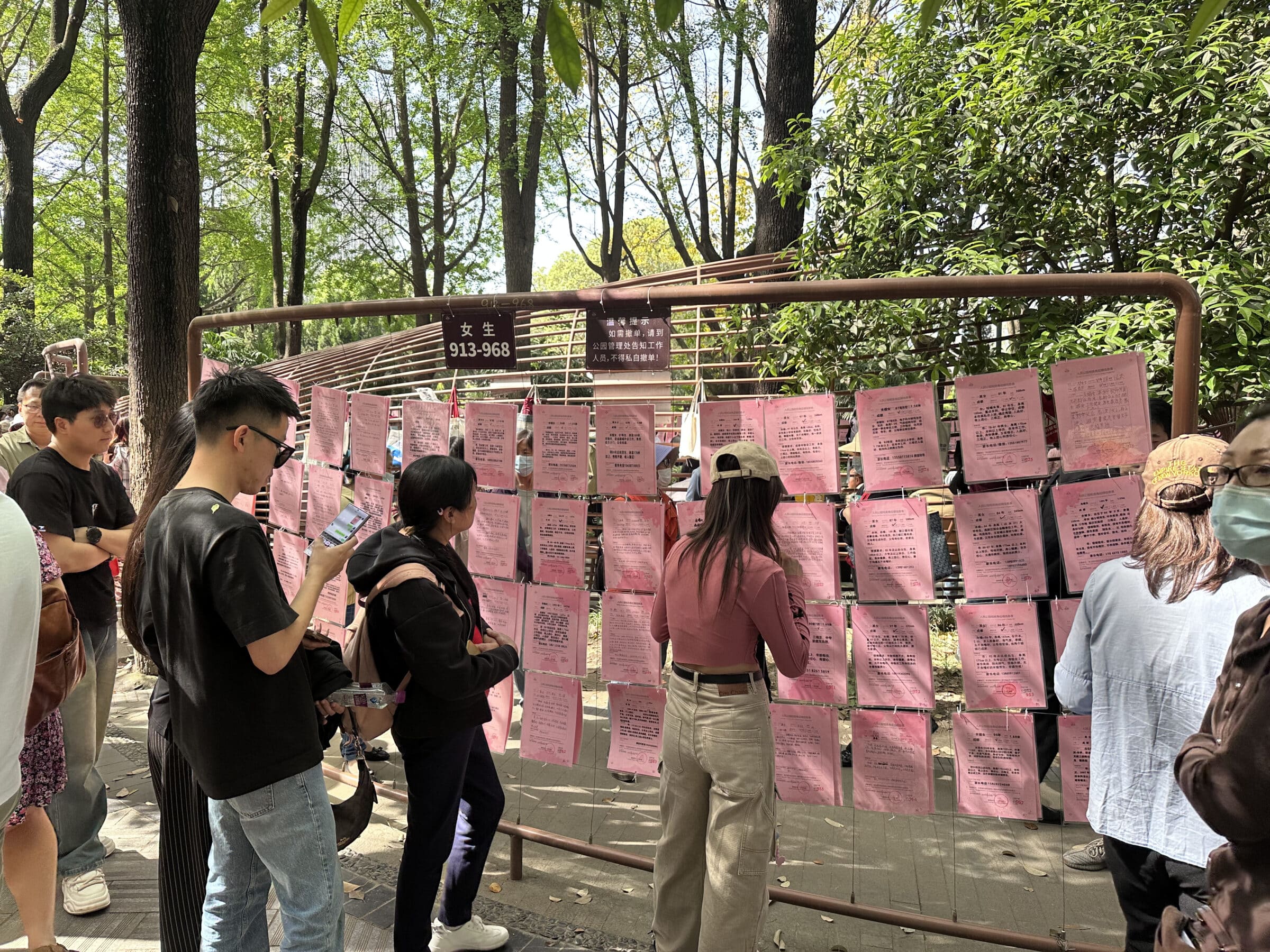

By the time we got home I was collapsing, so after skipping through many Chinese TV channels we watched a bit of Homestead Rescue on the Discovery channel, which is about as perfect an encapsulation of the opposite to the Chinese worldview as you could imagine. Later I roused myself for a late dinner, on the way to which we accidentally turned down a street filled from start to finish with pet shops. Now this is China: never just one of something when there could be 50. The same philosophy was clearly operating at the bakery after dinner where I wasn’t allowed to buy just one honey cake – no, it had to be six. (Total cost was still under a pound, and we ate them all.)
Day 10: Cycling the Tianfu Greenway
One of Randi’s discoveries when researching Chengdu was the Tianfu Greenway: a 100km long circular cycle route which makes a loop around the city and is entirely segregated from cars. During our time in Chengdu we rode on two small sections, and on our first outing we started in the east to finish in a surprisingly rural southeast corner. (It was a bit of a transport desert for the Metro, actually, but fear not: Line 13 is already under construction!)
Renting bikes is easy enough, assuming you have Alipay already linked to your mobile number. We chose the blue-coloured option, as apparently they have the smoothest process for foreign tourists. As ever, everything just kinda worked and was very inexpensive. And as ever, there were plentiful public toilets (plus water vending machines) all along the route.



Since we finished in the middle of nowhere, our route home was a bit haphazard – we jumped on a bus, but I didn’t want to swelter the whole time, so we jumped back off nearish a metro – which had the benefit of taking us through a truly ‘suburban’ feeling area. ‘Suburban’ in the sense that it’s clearly a ‘live here, raise a family commute into the centre if needed’ kinda place. Except the housing is still on a massive scale: a vast landscape of apartment buildings, built to a height which would induce heart attacks if you tried anything like this back at home.
Talking of raising a family: one of the bizarre things we walked past was an information display to promote the new ‘Family Education Promotion Law’ from 2022. The law itself, which I looked up later, is written in such broad-sweeping language as to be utterly alien to me as law. One subsection obliges parents to be:
Teaching minors to love the Party, nation, people, and socialism; setting up a conception of preserving national unity, solidifying awareness of the community of Chinese people, and cultivating sentiment for the homeland.
Also mandatory are to raise children to “admire virtue and be inclined to goodness”, “to be diligent and thrifty”, to “cultivate their positive social mores” and on and on. The information boards promote this law with a series of hypothetical (I assume!) case studies, including domestic violence, for which husband Hu may be reported to organisations in order to be “criticised and educated” with divorce following as an option later. On a lighter note, 8 year old Xiao Ming may dream of visiting the dance hall with his older cousins to dance, but “the purpose of prohibiting minors from entering entertainment venues is to protect their physical and mental health” and breaching these terms is a serious offence.
The final board outlines the legal obligations of adult children towards their parents, which in China are considerable. Courts are empowered to order children to pay maintenance or make mandatory visits to their ageing parents, which is a mind-bending exercise of state authority.
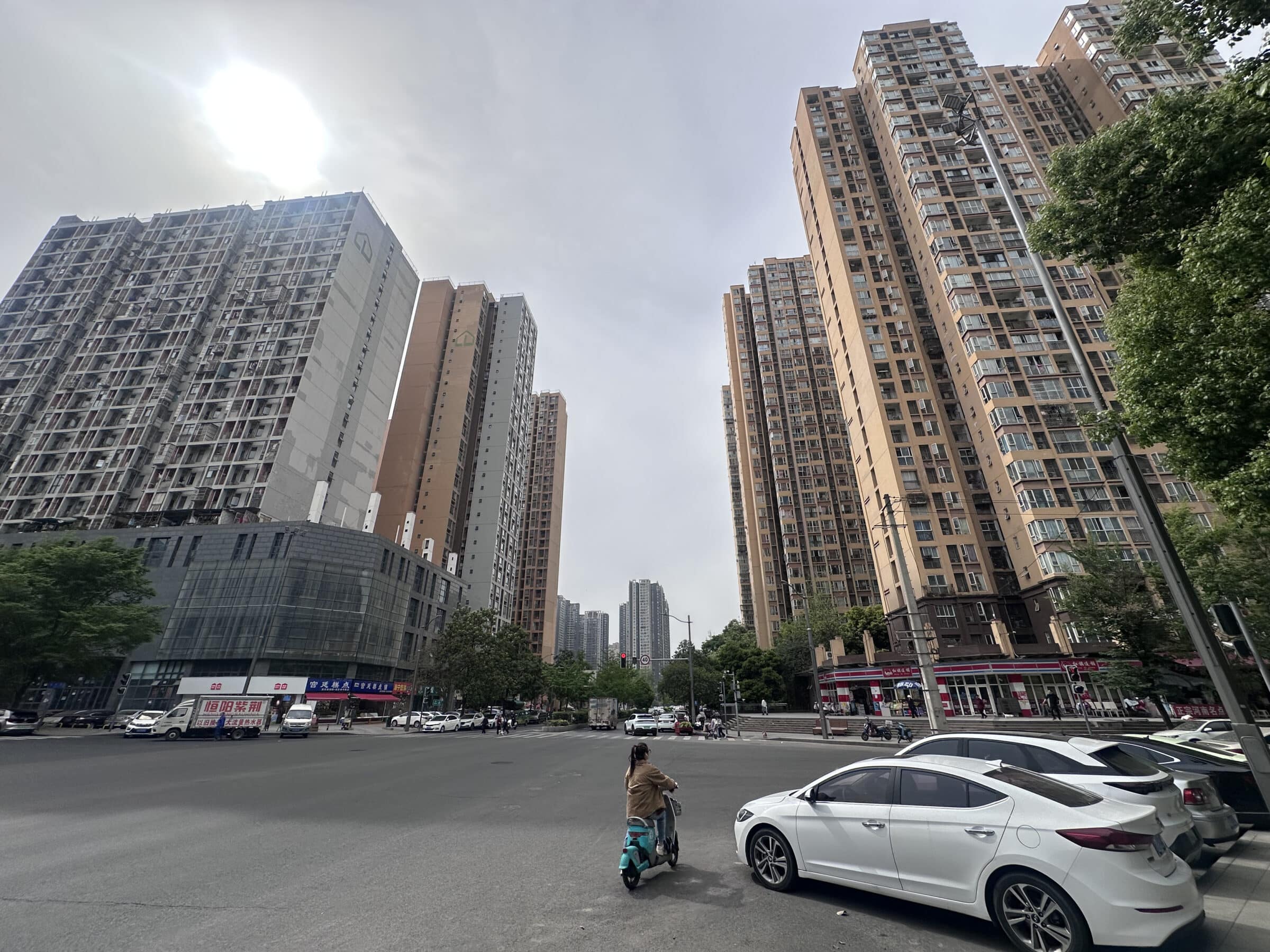
That evening, I cracked. Pizza Hut in Beijing had been a disappointment, but I wanted pizza, so we dined at Dominio’s. (Fun fact: everybody gets a pair of disposable plastic gloves to eat their pizzas with, and everybody uses them.) Then Randi successfully found somewhere selling regular playing cards (after a lot of failed attempts in anime-themed stores) and we played a few games of 7 Card Rummy and Speed from the fancy bar at the top of our fancy hotel.


Day 11: Pandas!
Pandas are everywhere in China, but in particular pandas are everywhere in Chengdu, which is world-famous for being home to a number of panda conservation sites. We opted for the ‘Chengdu Research Base of Giant Panda Breeding’ which is the easiest to get to (metro plus shuttle bus) and is a giant panda zoo with both indoor and outdoor sections.
It’s all very nicely done, with a natural walking route between the different zones, although it is quite funny how intense the crowds are around the first panda enclosure. Everybody (including us) is desperate to get a picture (top tip: stand behind the school groups!) but if you just walk a little further on you’ll find equally adorable pandas with no crowds.




Somewhat oddly, the zoo is also home to a collection of ‘red pandas’, which are a completely separate species (similar to raccoons) and only linked to panda bears by name, as well as being native to China. Sadly, these areas were closed on our visit, so we missed out on the red pandas and will have to go back.
This post is already massively long, so I’m going to cut it before concluding with the third and final part of our trip!
Just in time for Easter eggs… we’re back!
We’ve spent the last two weeks enjoying an amazing time in China. As you might expect, I took copious notes for this blog, starting with our first stop in Beijing. But before starting with our day-by-day itinerary, I wanted to try and capture my overall impressions of China as a tourist: some things I was expecting, and some things which surprised me.
- WeChat & Alipay are a way of life. I knew this already, but it’s hard to capture just how much China exists in its own technological world. It’s not just about payment – almost all of our restaurant meals began by scanning a QR code with one of these apps and using the restaurant’s mini program to translate the menu and submit our order. Public transport is almost completely tied to these apps too: I was able to use Apple Pay for the Beijing Subway, but not for the buses and not in Chengdu or Chongqing.
Thankfully it’s pretty seamless as long as you get fully set-up – including mobile number verification – before you arrive in China. Our only hiccough was that occasionally my Natwest Mastercard card couldn’t be used through these apps, but thankfully Randi’s HSBC Visa was always accepted. We also relied heavily on the English version of Gaode Maps, known as ‘Amap’ for navigation. Although we had no problem bypassing the Great Firewall through our eSIMs, the reality is that Google Maps is functionally useless in China. You just have to switch your habits entirely.
- You’ll see very few Western tourists, and you’re not special. To be clear, I mean that in a good way. We’ve been to lots of places where the local economy is geared around international tourists, but China is not that place. While there’s a surprising amount of English signage (plus voice announcements on all the metros we used) you only had to look around to see that even the big tourist attractions are geared for domestic tourism first, and anything else is a nice bonus. And while people were kind and patient if we needed help, with very few exceptions nobody gave us a second glance, although Randi wondered if things might be a bit different if we were blonde!
A lovely side-effect here is that we felt very unhassled. Nobody is trying to rip you off. There was no equivalent of the mysteriously broken taxi meter, or gouge pricing at tourist sites. I typed 30¥ rather than 3¥ into Alipay by mistake to buy a bottle of water once (divide by 10 to get pounds – everything was very cheap) and the guy looked horrified.
- The vibe is surprisingly quiet and relaxed. I had expected a lot of noise and bustle, but actually things felt pretty chilled and calm even when there were crowds of people. Chengdu is known for being laidback, but I felt this in Beijing too: a city which I found unexpectedly low-rise (at least by Chinese standards!). We learnt on our food tour that cars are forbidden to use their horns in central Beijing, and we also wondered whether not speaking any of the language caused us to tune more background noise out. Sure, compared to any European city the roads are much wider and everything is at a much bigger scale. But it’s nothing like Thailand or Vietnam for making simple things like ‘crossing the road’ feel slightly perilous at times.
- Things just work. Yes, we were wealthy tourists in big cities. But it’s a very easy place to be a tourist, because things just work. The trains all run. Everything is digitised. Streets are clean. There are free public toilets everywhere, which you really start taking for granted. And because the scale is so vast, there were times where it felt like I was strolling through an Asimov city from the future. At the same time, it also felt very insular. Beijing is nothing like London or Paris or New York: there’s very obviously no culture of immigration from overseas. The same forces which allow this vast country to power ahead with incredible momentum also make it feel a little remote from the rest of us. But perhaps that’s less true for its nearer neighbours.
OK, on with our trip!
Day 1: Arrival
After much deliberation, we had chosen a boutique hotel in one of Beijing’s hutongs. The hutongs are the narrow lanes, alleyways and courtyards found in the older, more historic areas of the city, as opposed to the modernised areas. Our hotel was in the Nanluoguxiang area, and it was obvious just from the walk from the subway that we’d made a great decision! The narrower streets had so much character, the main pedestrianised road was jam-packed with food and people in a market-like atmosphere.
Amusingly, the only way to reach our first floor room – which had its own locked door – was to walk through someone else’s room on the ground floor first. As it happened, nobody occupied it while we were there, but we always opened the door with some trepidation. After crashing a little bit, we had the huge thrill and relief of successfully paying for our first meal over WeChat, followed by a celebratory peanut-butter flavoured soft serve ice cream from the market.

Day 2: Summer Palace & Food Tour
The next day we got up early and headed off to the meeting point for our pre-booked Tiananmen Square and Forbidden City walking tour. Only problem: the tour didn’t exist. (In case you’re wondering how I can square this with the ‘nobody is trying to rip you off’ statement above – the company were extremely apologetic when Randi contacted them, and refunded us immediately.) So, we punted this for another day and headed instead to the Summer Palace. This is a large imperial site from the Qing dynasty, but unfortunately the only history which really stuck with me was the repetition of the phrase “…until it was burnt down by British and French forces” at every information board.
Afterwards, we walked to an outdoor food mall by a nearby transport hub for lunch, and Randi felt a little pang of suburban delight.
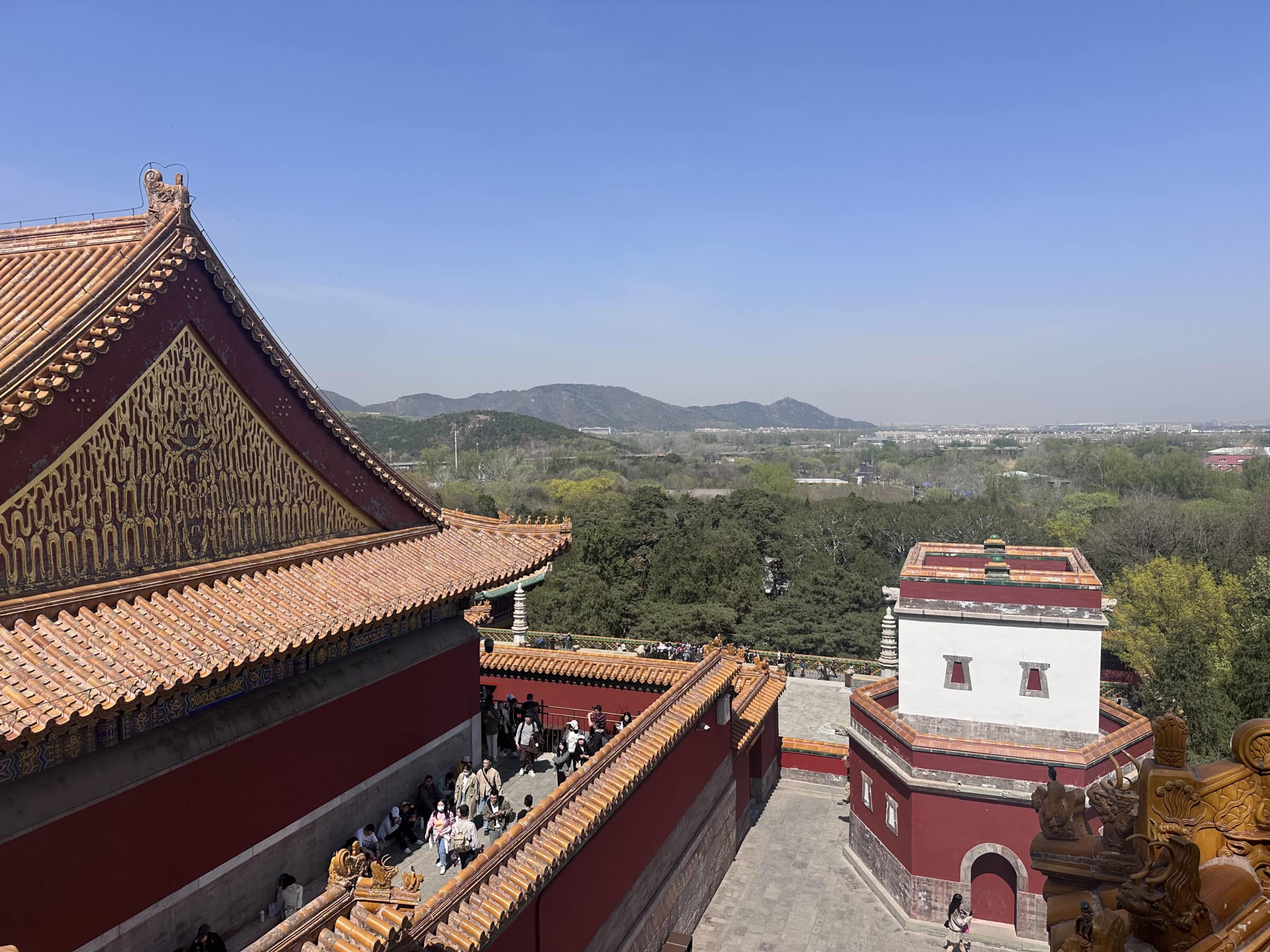


In the evening we took a superb Lost Plate food tour with Zoey, who guided our group through hot pot, traditional Beijing noodles, giant meatball dumplings (one of Randi’s favourites from our trip!) and a final feast of many dishes which left us all stuffed. (We were pretty smug that our hotel was on the same street as where the food tour ended, so we could just roll into bed.)
One very sweet moment was Zoey’s genuine incomprehension about why so many of her foreign tourists are so excited to bring up the Chinese high-speed trains they’ve booked as part of their travels in the country. “It’s because we’re jealous and we all want them!” we told her, in a chorus of pain.

Day 3: Olympic Forest Park & Wangfujing Street
Talking of trains: yes, Beijing’s subway is as good as you would expect, although (in common with Chengdu and Chongqing) you do have to pass through security when entering any station. (“This wasn’t built by rival Victorian railway companies, was it?” asked Randi pointedly, after we felt how smooth the rides were.)
One especially nice touch is the unique artwork and design at each station, and my favourite was the station closest to the Olympic Forest Park which we visited on our third day. Built specifically for the 2008 Olympic Games, the park is beautifully landscaped and provides a great view of the Olympic Tower and Bird’s Nest stadium from the top of a hill. (Well, I say ‘a great view’ – the elephant in the room are the pollution levels, which did not massively affect me but Randi felt more viceraly off-and-on during our trip. You certainly could see further with less pollution, in any case.)




Afterwards we strolled down towards the Olympic buildings themselves, and I persuaded Randi that we should definitely pay to enter the lonely looking ‘flying cinema’ tent for a 10 minute virtual ride over China. In my defence, this was actually quite fun (even if we were the only customers!) and did help to orient me with major Chinese cities and landmarks. Even if the the detour over Taiwan was a little awkward *cough*.
That evening we visited Wangfujing Street, Beijing’s main shopping street (and Oxford Street equivalent) near the centre of town. I don’t have much to say about this. It was fine, but since we didn’t have any interest in going shopping it absolutely reinforced our decision to have booked a hotel in the hutongs instead!
Day 4: Great Wall & Livehouse
I was fully expecting the Great Wall of China to be one of the absolute highlights of our trip, and it didn’t disappoint. Following advice we chose to visit the Mutianyu section of the wall in a tour bus, which handled all of the entry logistics but then left us alone to tackle both the East and West sections in our own time. The East section is shorter, reached by chairlift and notable for having the option to toboggan down again once you’re done! Meanwhile, the West section concludes with a steep ascent which provides breathtaking views over the whole area. Do them both!
I don’t think I’m going to be able to write anything original about the Great Wall, but it was a great experience and felt like a great time of year to be doing it. The toboggan was a lot of fun (even if we ended up forming a queue behind a very slow rider!) and we very much appreciated the giant buffet lunch afterwards. (Side-note: I have to imagine that the Oba-Mao mashup t-shirts which are still on sale in the tourist areas did double duty at Republican conventions in the US, back in the day.)





Back in Beijing, we found a Peking duck restaurant for dinner. Despite being on the fancy side (at least compared to most of our meals) the owner turned out to be a delightfully chatty guy from Singapore who spent his time wandering between tables talking about everything from his music selection (“music should be fun!” he cried, as Boney M’s Rasputin played in the background) to his haul of medals from cooking competitions (“in my younger days”) to how nervous he was for a potential job interview tomorrow morning with a big hotel chain. We wished him luck, although naturally he was doubly nervous as Trump’s idiotic tariff war was reaching full market meltdown as we ate. (And yes, it wasn’t lost on us that we were living through a world historical attempted severing between the US and China while we were there.)
Oh, and the duck was delicious too!
Before heading home for the night we decided to walk around the nearby Houhai Lakes, and quite by chance we ended up rounding the day by discovering an incredibly fun music scene! We think – but are open to correction – that these qualify as ‘livehouse’ venues, since they’re definitely more public venues than private KTV karaoke. We had a lot of fun sampling the competing performers along the stretch, before plumping for our chosen venue and waving our foam accessories in the air with enthusuiasm.
Our band (unclear if they are actually a band or a random assemblage of people) was particularly notable for featuring one girl who put in absolutely zero effort unless it was her solo (to the point of yawning or staring at her phone while on stage) being perfectly balanced at the other end by someone dancing in a fascinator hat who was game for anything that came on. We loved them.
Other livehouse notes:
- While I was drinking by far the most expensive beer of the entire trip, this wasn’t an alcohol-soaked atmosphere by any means. In fact, the unimpressed-looking guys which can be seen sitting next to Randi in the second video were drinking tea out of a fancy tea set.
- The banger in the last video is 化蝶飞 (The Flowers). Yes, part of it is a shameless rip-off from Dragostea Din Tei. I know this because I messaged my tour guide for Chongqing on WeChat with the video asking him to identify it for me…

Day 5: Tiananmen Square & Forbidden City
And so, with catchy livehouse tunes still running through our heads, we spent our final day in Beijing seeing the tourist hotspots we’d been thwarted from seeing on our first day: Tiananmen Square and the Forbidden City.

The main thing to say about Tiananmen Square is that it’s absolutely huge. As in, it’s just much, much bigger than anything I’ve ever seen in any other country. Our guide gave us 10 minutes to explore and I used most of this time just walking over to the ‘parliament’ building on the other side. (The National People’s Congress is the largest legislature in the world, but it only meets once a year for about two weeks.)
Of course, as you go through three separate passport checks to enter it (!) it’s also impossible not to be thinking about the 1989 Tiananmen Square protest, although I was a little surprised that our Chinese guide chose to bring this up of his own volition while pointing out the sights. Then again, this was very much in keeping with the self-confidence which we found everywhere in China. Who cares, I suppose, what English-speaking tourists think?

As for the Forbidden City: I confess I didn’t really know what this was beforehand, but was surprised to find that this old centre of Imperial governance – which backs onto another side of Tiananmen Square – is almost entirely open-air. There’s such an obvious continuity between these vast spaces, from where China’s emperors once ruled, and Mao’s own expansion of Tiananmen Square itself: made all the more obvious by the giant portrait of Mao which now sits forbiddingly over the entrance.




Our guide took us on a potted tour through imperial Chinese history (including the plot of the Last Emperor) before we emerged at the Forbidden City’s north exit, grabbed lunch and then enjoyed a “Hawthorne in the alley”-flavoured ice cream, at least per Google Translate. (Make of that what you will, but it was the clear winner from Beijing!) Finally, we climbed the hill in nearby Jingshan Park for the panoramic views over the Forbidden City – and the rest of Beijing – before collapsing home after all of this patient sightseeing.


That just about wraps it up for our Beijing section, although I’m sure I’ve forgotten things, and I kinda missed having my laptop (as I had on our world travels) and being able to blog each destination as I went.
I should confess that on our final night we did venture into Pizza Hut – one of the big Western brands which you see dotted around – for a quick break from Chinese meals. But this was a bit of a letdown, as Pizza Hut in China has strayed pretty far from its pizza-based roots!
This aside, Beijing was an incredible city and a perfect start to our holiday in China.
13th April 2562, Bangkok.
The night before we had acquired our arms from a nearby dealer. It was a necessary act of self-defence to protect ourselves from trouble but also signalled our own commitment to fight, and we familiarised ourselves with our new weapons with a hastily arranged target practice back at base. This was not enough to protect me from a first strike the next morning on neutral ground – a victim of some ill-disciplined young fighters who found excitement in an unprovoked attack – but the majority of the battle was confined to designated combat areas other than some stray shots from passing vehicles. Some, like us, came from abroad but the majority appeared to be locals who had been looking forward to the scrap for some time. They expected the fighting to last for three days.
We arrived at the scene, suitably uniformed, to a war of all against all – but the majority of us formed a slow procession, not a scrum, as we marched along the road. At unpredictable moments the crowd would break into a roar, in a surge of emotion, or descend on a single victim with the passion of the mob. But much of the battle was marked by remarkable self-discipline fuelled by a shortage of ammunition. Profiteers enriched themselves by selling extra rounds by the side of the road, although they remained vulnerable to attack themselves and were frequently hit. Only the police seemed immune to fire, guarding the site but doing nothing to prevent the carnage before them. I regret to say that my weapon was no match for better-armed opponents who fired with more powerful guns, and I came away thoroughly vanquished but proud of the small part I had played.
I had a great time at Songkran.



Joking aside, Bangkok’s multi-day New Year celebrations (based on the Buddhist calendar) is so much fun, and the entire 5km length of Silom Road is blocked off for the giant water fight you can see in my hastily snapped photos. Even more charming, though, are the kids who wait eagerly alongside ordinary roads, ready with buckets of water for any passing vehicles or pedestrians. Of course, this only really works in a hot country where getting soaked is not going to chill you – it’s nice, actually, that a tradition is so naturally rooted in the particular geography and climate.
Other than water fights, we also enjoyed wandering through the Songkran celebrations at Lumphini Park, where we bought dinner from some of the many food stalls and sat watching musicians perform as the sun went down. But otherwise, part of the reason we turned our Southeast Asia route into a loop from Bangkok (which we visited a month ago) was that we wouldn’t feel a great pressure to explore one last place. Instead, we’ve been trying to lay the groundwork for a return to ‘normal life’ by applying for jobs and suchlike. Which is not that interesting to blog about 😉

And… that’s it! Tomorrow morning we set off for the airport and a direct flight home to London. I am planning one last wrap-up post about our whole adventure before this blog returns to its usual frequency. If you’ve been reading specifically for this series then I hope it has been enjoyable/helpful/a source of silly photos. Goodnight!

We only had one full day to explore Phnom Penh, the capital of Cambodia, and although that obviously isn’t long enough to really get to know the city, this is a place which leaves strong first impressions and is steeped in contradictions. Compared to Saigon it is simultaneously much greener and easier to walk around – there is a long, pedestrianised river walk, somewhat calmer traffic, multiple parks and many other open spaces – but elsewhere it’s also dirtier, with more rubbish lying around than we’ve seen anywhere else. The primary focus for visitors is to learn about the Cambodian genocide – tuk tuk drivers will nonchalantly ask “Killing Fields?” as you walk by – and yet that past is less walled off from today’s politics than you might assume. Even the currency is double-headed: most prices are in dollars, but for change under $1 you will start to accumulate riel (the national currency which is still widely used in rural areas) and shops are unfazed if you want to mix and match the two.





We really wanted to make the most of our day here, so we got up reasonably early and walked around until the sun got unreasonably hot, from the temple at the top of Wat Phnom hill (it’s a very small hill, but apparently the city’s only one) down the river walk and to Independence Monument, which is near another monument commemorating the friendship between Cambodia and Vietnam. The more I read about the history of Cambodia, the more complicated this ‘friendship’ seems.
Once the temperature reached its afternoon peak and we had exhausted our capacity for walking we made our way via tuk-tuk (you can use Grab to order tuk-tuks here) to the Tuol Sleng Genocide Museum. It’s on the site of a former high school which was turned into a concentration camp by the Khmer Rogue between 1975 and 1979. Across the country as a whole, somewhere between a fifth and a quarter of the entire population was killed during the Cambodian genocide, including from malnutrition and disease in the rural labour camps which the entire urban population was forced into. At this site, known as S-21, an estimated 20,000 people were tortured and killed with only a handful of survivors.
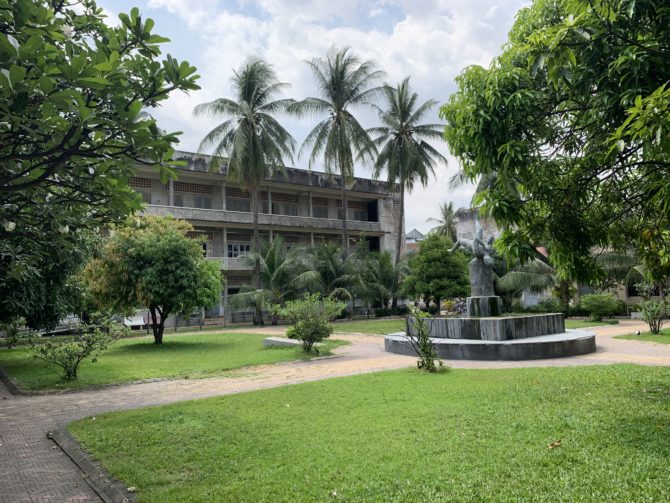
You can tell that it used to be a school. The buildings are long rectangular blocks, three storeys high, arranged around a central courtyard. The atmosphere is kept respectful by an audio guide, which most people chose to use, which means that people are walking around in silence as they listen. It’s exceptionally well done, with sensitive warnings so that you can skip the most brutal accounts of the torture itself, as I did. Just walking through the rooms has a nightmarish quality. I was more interested in learning about the background to the catastrophe, which I learnt a lot about from the audio guide and then continued to learn more that evening by starting to read a book about it (Pol Pol: The History of a Nightmare).
As is always the case with these modern, twentieth-century genocides it is the ‘bureaucracy of death’ which is the most chilling: the forms, the processes, the endless photos of prisoners wearing numbers for identification. I look at the photos and tried to pick out some individuality – who looks resigned, confused, frightened, defiant, powerless? But it didn’t matter; they were all killed just the same. What was unusual about the Khmer Rouge was their ideological extreme. This wasn’t ‘just’ a revolution, it was an attempt to completely eradicate the concept of the city and ‘return’ everyone to a fantasy agrarian state. Seen in that light, and with the photos of the bombed-out wreck of Phnom Penh in the 1970s, it made me appreciate this city’s modern existence all the more.
On the way back, our tuk tuk driver told us that he was going home to his village for Cambodian New Year. I asked if he was going to see family, but I think he said that they were all dead. It was difficult to make out what he was saying above the noise of the tuk tuk ride, and anywhere else I would have assumed that he must have actually said something else, but in Cambodia all this is recent memory. He went on to complain about the corrupt government in power today. And while there have been some trials, there is no clean slate – there never is, especially with civil wars – between the crimes of yesterday and the people in power now.

We spent most of the next day travelling from Phnom Penh to Siem Reap, the city which is the base for visiting the famous temples of Angkor. Angkor was the capital of the Khmer Empire between the 9th and 15th centuries and is now a huge, sprawling site of buildings and ruins. As I read more about Cambodia’s modern history, it’s clear that this sense of a ‘past greatness’ which was lost has been a huge and destructive influence, and this was reinforced by our visit to the Angkor National Museum. History is divided into the pre-Angkor, Angkor and post-Angkor periods and it is clear which one you are supposed to focus on, with dramatic background music accompanying sweeping videos of glorious temples like something out of a 1990s fantasy adventure movie. (And yes, there are many other countries which are obviously afflicted by the sense of a lost golden age, most definitely including Britain.)
In theory you are ‘supposed’ to spread your Angkor visit out over three days. But given the heat, we decided to pick one day to set our alarms for 4am, go see the sunrise at Angkor Wat and then enjoy whatever else came our way before we ran out of energy. Our tuk tuk driver, Thorn, was a friend of our AirBnb host and was amazing – picking us up in the dark and then driving us around five temples in total before we called it a day. So here is a short summary of what you might see if you visit Angkor. It’s most definitely not comprehensive, but did give us a good variety in the time we had.
Angkor Wat: The Big One


So this is the famous one, the one you’ve already heard of and came to Siem Reap to see in the first place. Originally a Hindu temple – and possibly also a mausoleum – it is now Buddhist and still an active place of worship, although the feeling inside is somewhere halfway between ‘in use’ and ‘abandoned’. I might call it ‘slumbering’. We watched the sunrise along with many other people and then climbed to the top of the central section of Angkor Wat; it’s such a huge structure that it didn’t really feel crowded despite all of the tourists. The walls are beautiful and decorated with huge bas reliefs of Indian epics.


Prasat Bayon: Indiana Jones Adventures


This was my favourite temple, and I’m not ashamed to put that down to the inescapably Indiana Jones vibe. Bayon, which lies in the middle of what was once the city of Angkor Thom, has a lot more of a ‘ruined’ vibe than Angkor Wat and feels more intimate to explore. Walking over wobbly bricks reminded me of a particularly well-made escape room, except of course this is real. The most striking parts are the giant faces which are built into the temple itself.


Prasat Baphuon: The Pyramid and the Portal
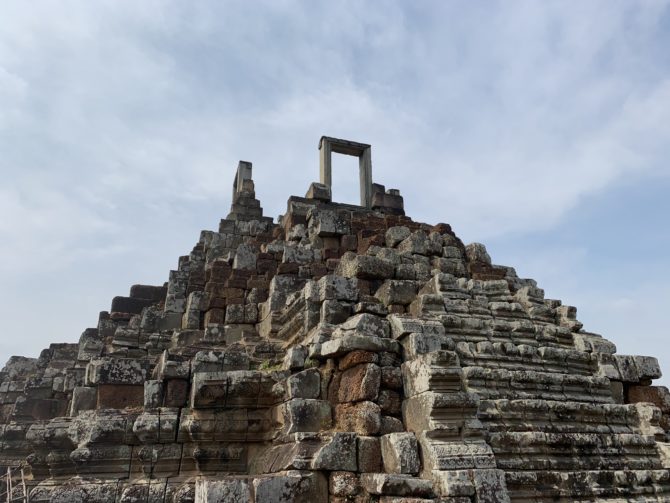
OK, so the archway at the top of Baphuon Temple is probably not actually a gateway to other worlds. But I would like to think so, especially since it took a couple of steep staircases to get up there in the first place and by this point in the day we were both starting to fade. Wisely, the Cambodian government does not allow you to actually reach the top and pass through the portal itself. (Look we didn’t pay for a tour guide so I can’t give you the full history of these temples. Although sometimes we did stand near to other groups and accidentally learn something.)


Ta Keo: Broken Chess Pieces
I was planning on calling this ‘The Boring Reconstructed One’ but that is overly harsh. Based on the before-and-after photos on the panel displays, however, the downside of restoring the structure (built entirely out of sandstone) is that it makes it somewhat less awe-inspiring to visit. I did like what looked like a box of giant broken chess pieces, though.


Ta Prohm: Collapse in a Forest
Finally, we reached Ta Prohm which is in the middle of a forest and presents a vision of the future where all the humans have died off and everything we ever built is slowly reclaimed by nature. According to Wikipedia, this is closest to the condition that almost all of the temples at Angkor fell into after the fall of the Khmer Empire, which must have been incredible when they were first rediscovered centuries later.



After our Angkor excursion I took an afternoon nap and woke up to discover that the power was out. Our AirBnb host confirmed that this was a city-wide problem (except for some parts of the tourist centre) caused by storms in Thailand and was expected to be fixed by 10pm that night, which it duly was. The disadvantage was that we lost our air-conditioning and fans for a few hours, but on the plus side it was pretty romantic and atmospheric at our candlelit dinner which our host very kindly offered to drive us to.
It is worth noting – and I have been looking for a place to shoehorn this in – that even in the middle of a power cut the 3G mobile data in Cambodia was not only working but still faster than much of the WiFi we used in South America. This has been true all over Southeast Asia and it really makes me wonder what is going on in South America to make the Internet so much slower.
The rest of our time in Siem Reap has been deliberately slow-paced. I had imagined a sleepy small town whose only existence was as a gateway to Angkor, but actually it is a fairly built-up city with a bustling tourist area downtown by the river. (It was here that we found a New Zealand bar serving real honest-to-god pies and mash, which might sound ill-suited to the weather but was amazing after so many months!)
Anyway, congratulations if you’ve made it through this epic post of civil war and ancient temples. It’s telling that of all the countries we’ve visited on our travels over the past five months it has been the extremes of Cambodia’s recent history which has driven me to pick up a book and go deeper into the history of the country, something which I will still be reading after we cross the border back into Thailand tomorrow. And in less than a week, I will be home!




















